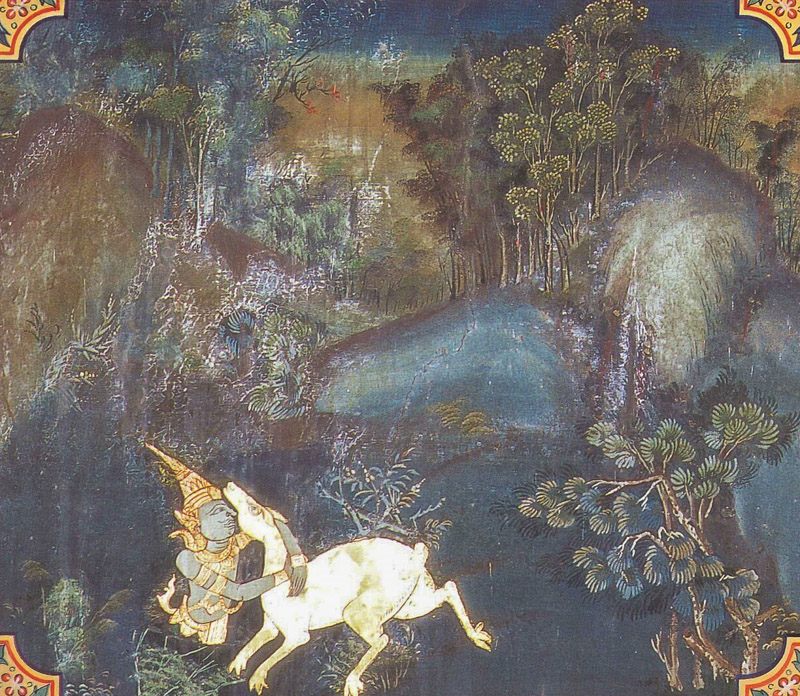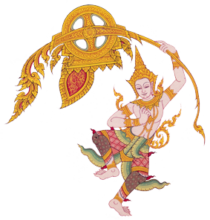
The Bodhisatta was once a deer. The king was an avid hunter, and considered himself the manliest man in the kingdom. During a hunt in the forest, his courtiers surrounded a thicket and beat the ground with clubs, driving the Bodhisatta out and straight toward the king. The king let an arrow fly, but the clever Bodhisatta rolled safely out of its path. When the king saw the Bodhisatta dive down, he assumed he had hit him and yelled out a cheer. But when the Bodhisatta rose and ran off, the courtiers loudly mocked the king.
The angry king chased after the Bodhisatta. He didn’t notice a deep pit full of water because it was obscured by weeds, and he fell in. The king couldn’t swim, and the Bodhisatta saw him struggling. He felt pity, not anger, toward the king and rescued him. The king was deeply grateful and he invited the Bodhisatta to come rule over the kingdom. But the Bodhisatta only asked that the king follow the five precepts and encourage his subjects to do the same.
The king was so taken by the Bodhisatta’s righteousness that his eyes filled with tears. When he returned home, he proclaimed by the beat of a drum that everyone in the city should follow the five precepts—though he told nobody about the near-death experience that prompted his conversion. However, early the next morning, his chaplain heard the king in his bedroom chanting his aspirations to live a righteous life and was able to guess everything that had happened the day before. The king was so impressed by his chaplain’s wisdom that he gave him a big gift.
Without fail, the king dedicated himself to giving alms and doing good deeds, and the people followed his lead so faithfully that heaven began to fill up with many new gods. Wondering what was causing the heavens to swell, Indra, king of the gods, saw the king’s devotion and divined how the Bodhisatta had set everything in motion due to his perfect virtue. Indra felt people should know about the Bodhisatta’s greatness, so one time when the king went target shooting, he made the Bodhisatta appear in front of the target. Then Indra entered the chaplain’s body, urging the king to shoot and kill because deer meat is for warriors. To explain why he didn’t shoot, the king told those around him how this noble deer had rescued and preached to him. Then Indra appeared floating in the air and praised the king.
In the Lifetime of the Buddha
After Pindola Bharadvaja, one of the Buddha’s top disciples, had risen into the air to reach a sandalwood bowl, the Buddha rebuked him for using his supernatural powers to do a cheap, pointless trick and issued an order forbidding his disciples from using their powers. After this order was given, some heretics who wanted to create a schism among the Buddha’s followers wrongly assumed the Buddha would no longer do miracles, so they said if he performed one, they would do one that was twice as good. To the shock of the heretics, the Buddha accepted their challenge since he was not a disciple and the rule did not apply to him. He had the king send his town crier out announcing that in seven days the Buddha would perform a masterpiece called the Twin Miracle under a mango tree. To thwart him, the heretics cut down all the city’s mango trees.
On the day of the show, the royal gardener gave the Buddha a delicious mango. After eating it, he had the gardener plant the seed in the ground, and it grew instantly into a giant, perfectly formed tree full of ripe fruit. A vast crowd of humans and gods gathered around the tree, and the Buddha ascended onto a jeweled pavilion built by Indra and began the Twin Miracle, so named because it featured opposites. Flames shot from one half of his body and water streamed from the other, alternating between top and bottom and left and right; and all the while, six-colored rays of light shone out of every pore of his skin, lighting up both heaven and hell. The whole multitude was in awe and filled with faith. (The Buddha performed the Twin Miracle twice; the other time is discussed in Jataka #547.)
After the miracle finished, the Buddha spent the rainy season in heaven preaching to the gods, including his birth mother. When it came time to return to the realm of men, the Buddha sent word so people could come greet him. Then he descended on a triple staircase, one each made of jewels, silver, and gold, accompanied by Indra, Brahma, and Suyama. The Buddha was greeted first by Sariputta (who had been the chaplain in an earlier birth), his wisest disciple, and he thought everybody should know that Sariputta was the wisest. So he began to ask people questions, each one more difficult than the next. Only Sariputta could answer the final question, and he answered in full detail just as if the Buddha had spoken himself.
The next evening, the Buddha heard some of his disciples discussing Sariputta’s excellent wisdom, and he told them this story as an example of Sariputta’s wisdom from the past; being able to guess the full story about the rescue from just a tiny bit of information.
The king was an earlier birth of Ananda, another of the Buddha’s top disciples.
